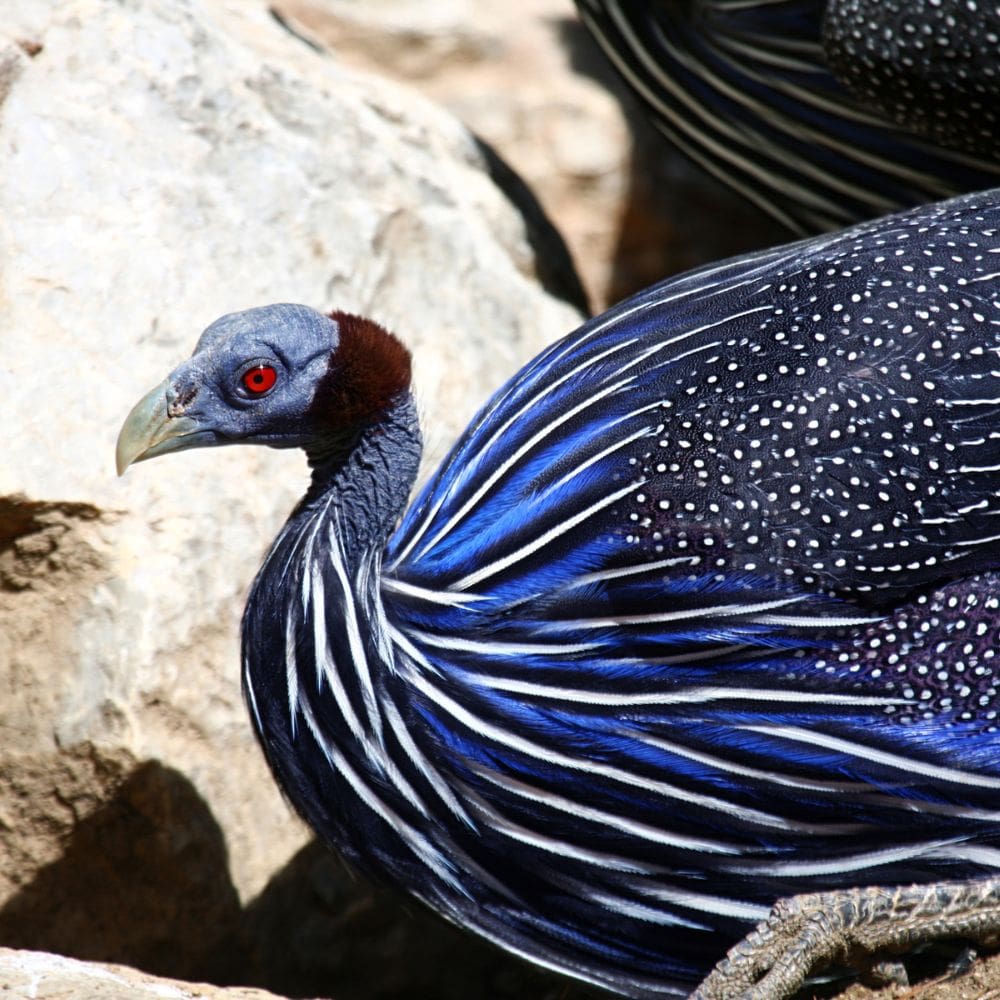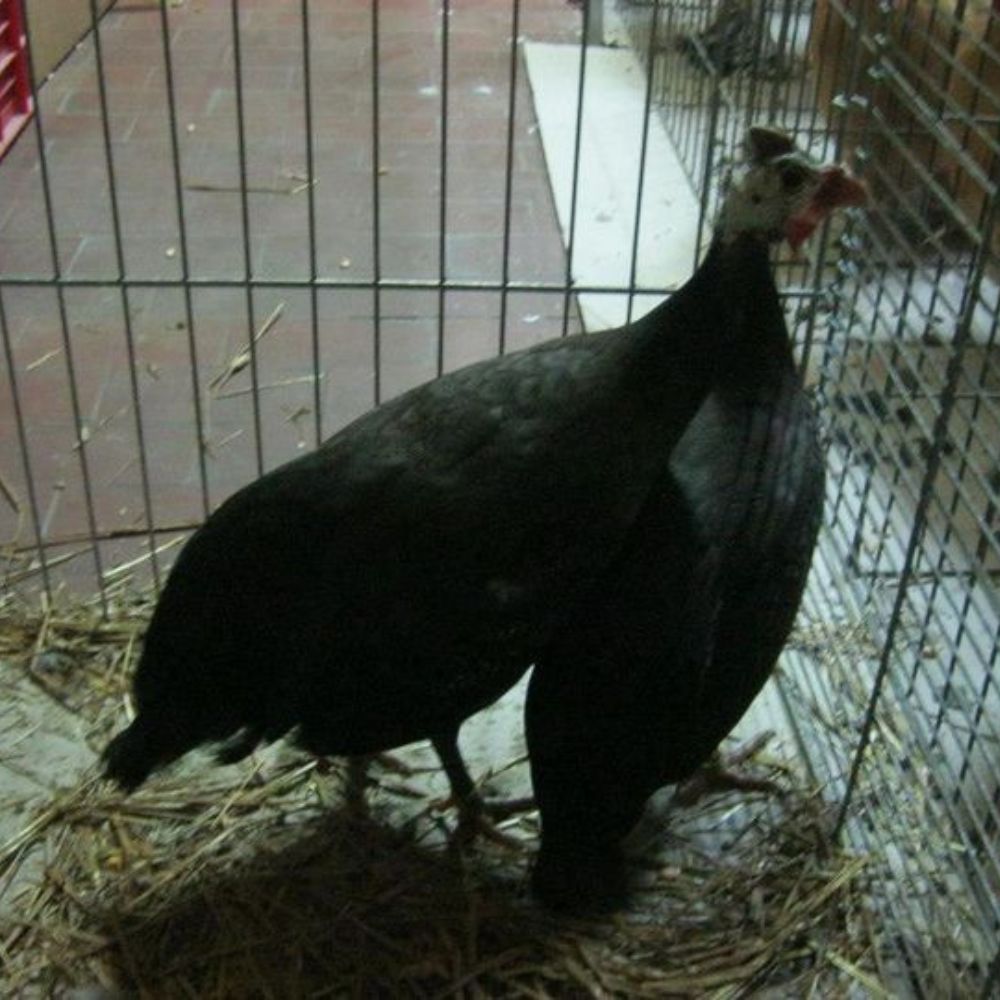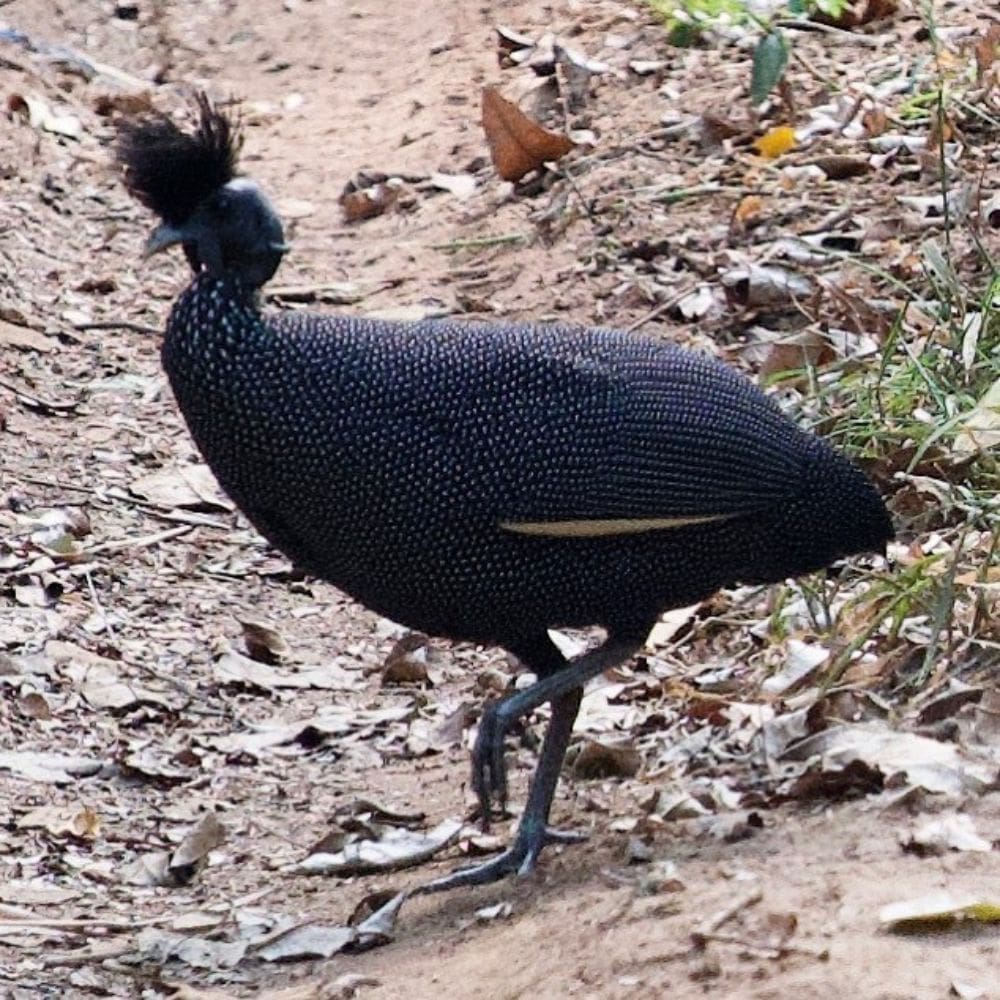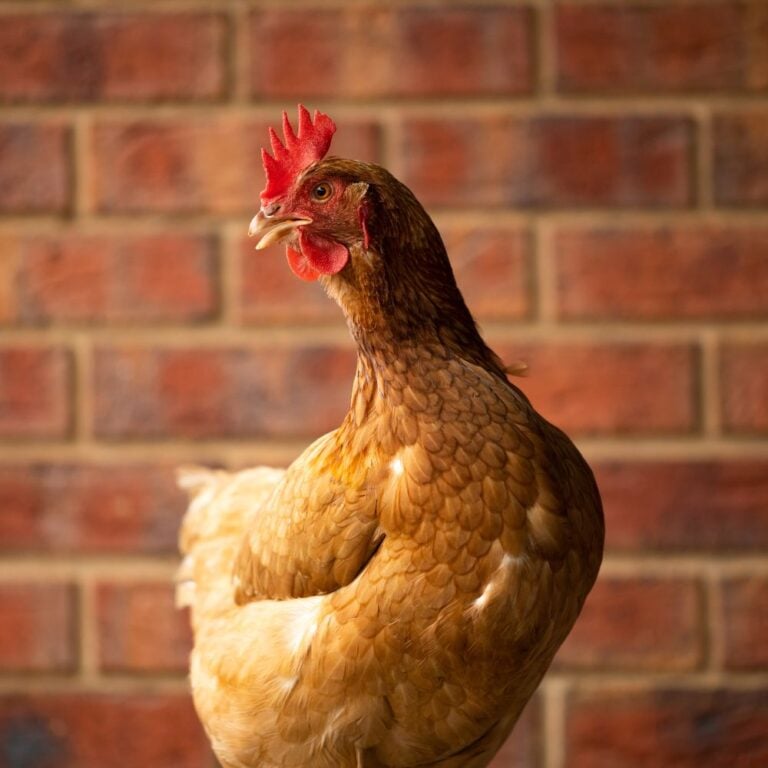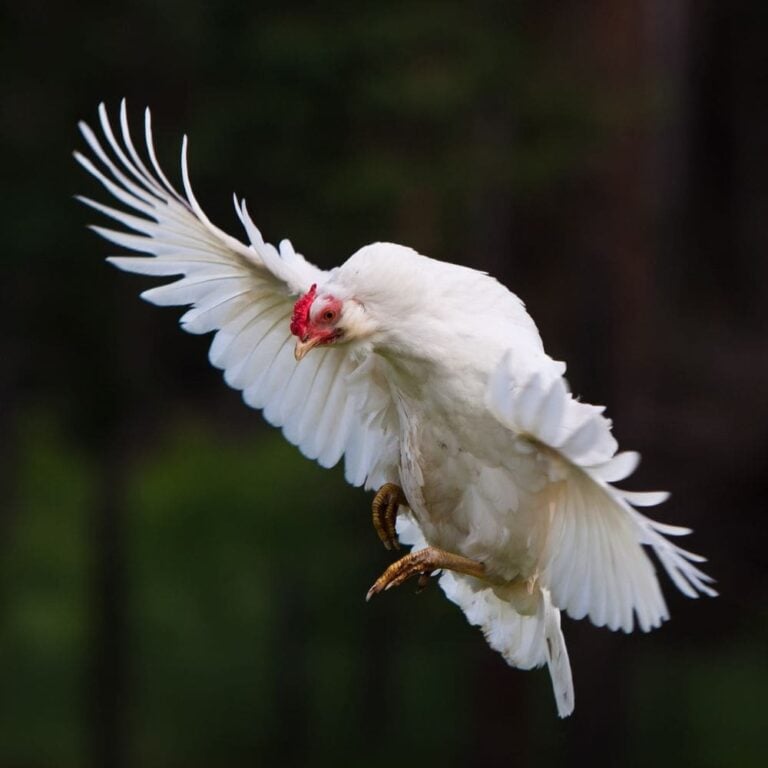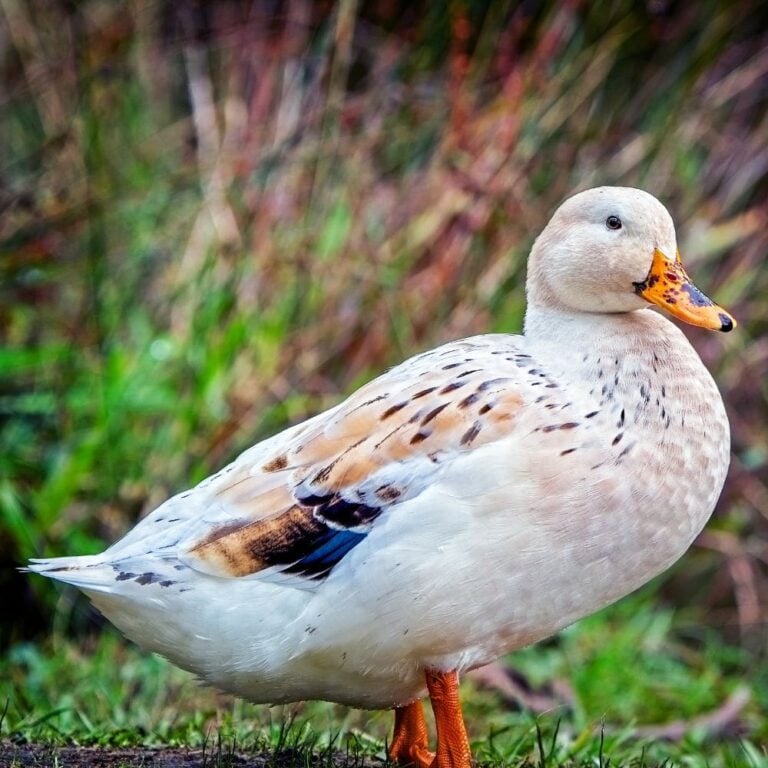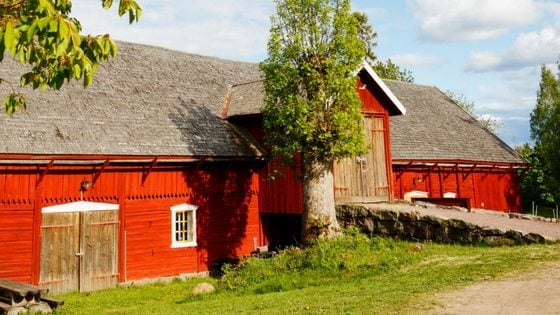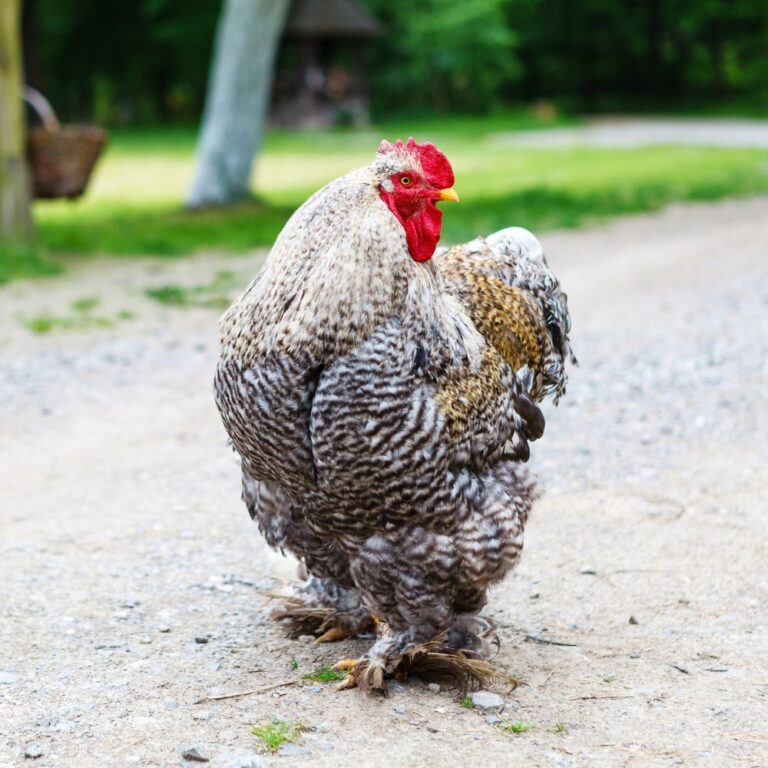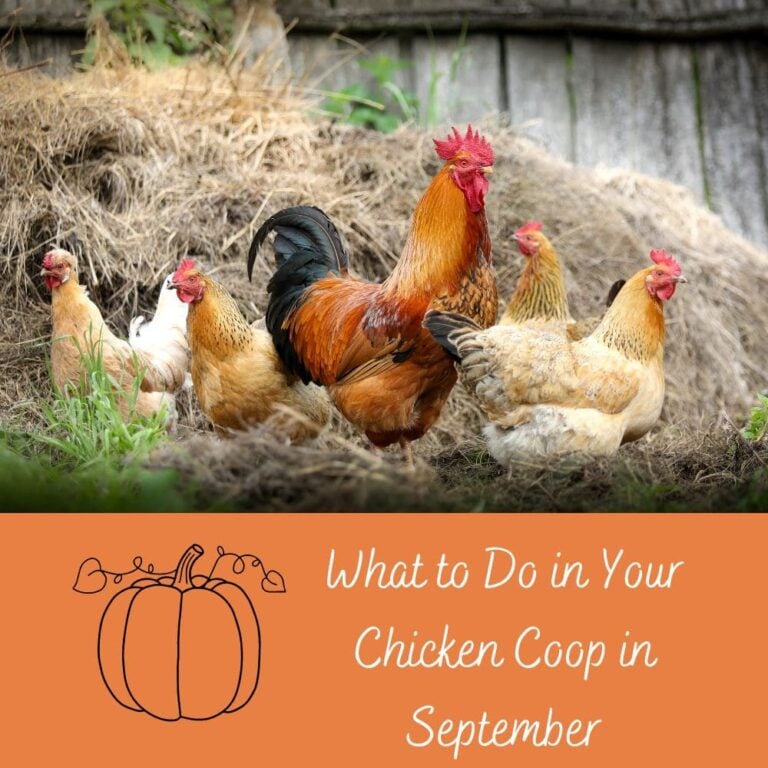The Guinea Hen, and Guineafowl in general, are extraordinary. You may not realize that at first glance, but these oddballs are worth their weight in gold around the farm.
I won’t be the first to say it out loud, but Guineas are peculiar-looking feathered friends. The first time I ever say one, I’m pretty sure I exclaimed “What is THAT?” 😆But the more I learned about these members of the flock, the more valuable I realized they truly are.
Give me a chance to show you how these extraordinary birds are…..EXTRAordinary!
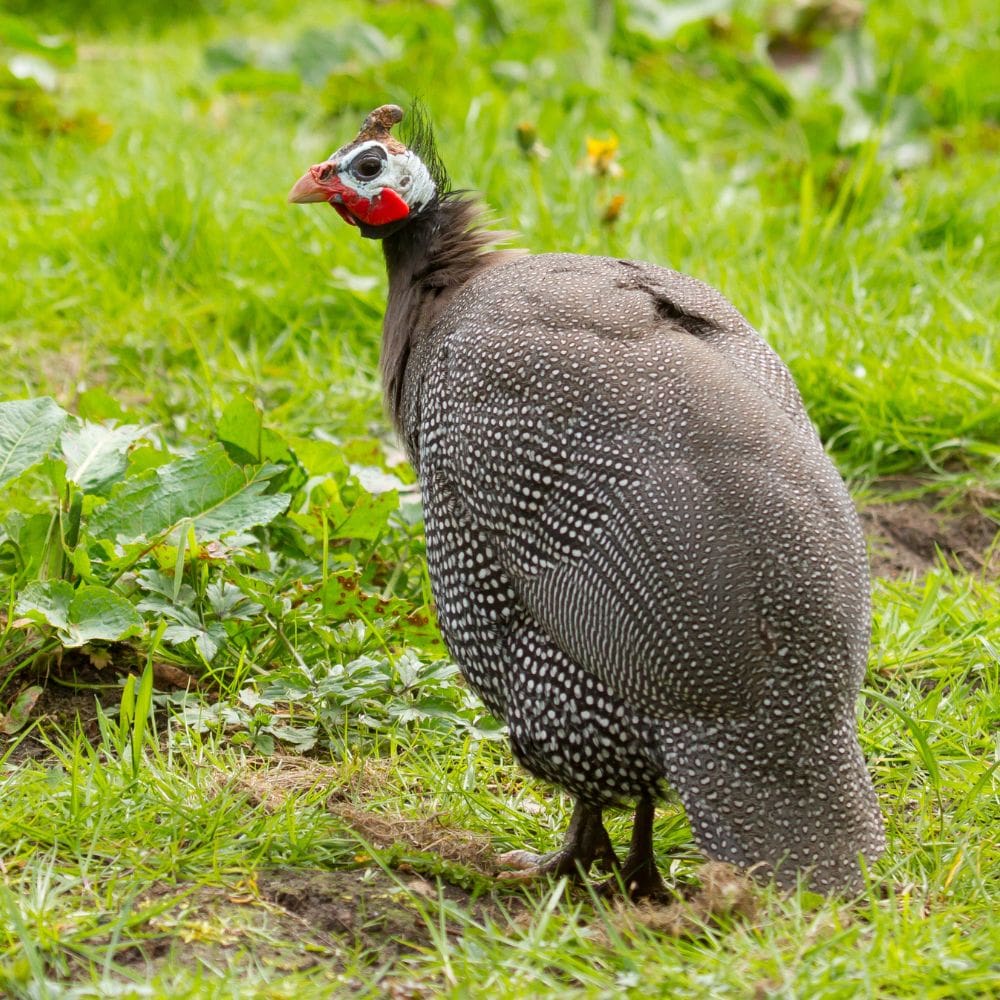
Table of Contents (Quickly Jump To Information)
What is a Guinea Hen Anyway?
It’s a type of fowl that originated on Mars….well, not really, but there sure do look “out of this world!” Guineas come from Africa and they have been around so long there are even drawings of them in some pyramids. There are 6 to 8 varieties of them (depending on the source you refer to), and they all come from African regions.
What Does a Guinea Hen Look Like?
Ok, I’ve already given these birds a lot of flack for their looks. I guess I’m a Guinea bully, and so is my 12-year-old daughter (who just said “I don’t like their naked necks but I like their feathers! 😆). So let me change my ways and tell you something good about their looks.
First, I should explain that there are several varieties of Guineafowl. I’ll list those here in a moment. For now, we will focus on the most common variety, the Helmeted Guinea fowl. The “helmet” is the horned-shaped thing on the top of their head.
Their plumage is super fun! The small-headed, big-bodied, polka-dot birds, are like something you might see in a Dr. Suess book. Although they are polka-dotted, they have dark gray feathers which may appear black from a distance.
Their faces and heads are really a work of art, perhaps a type of abstract art — but art nonetheless. Bald, featherless heads and necks are the immediate factors that set them apart from chickens.
They have faces that look like they have been painted white or blue, with bright red wattles. This “painted” look always brings clowns to mind. Take that little factoid any way you like 🤡.
After that, you take notice that their round bodies are shaped quite differently than chickens.
What Varieties of Guineafowl Are There?
It’s a bit hard to find the exact answer to this question, but it’s safe to say there are at least 6 varieties (and variations within those varieties). Each of them is EXTRAordinary in looks and actually quite appealing in their own way. Check out these varieties and their photos below.
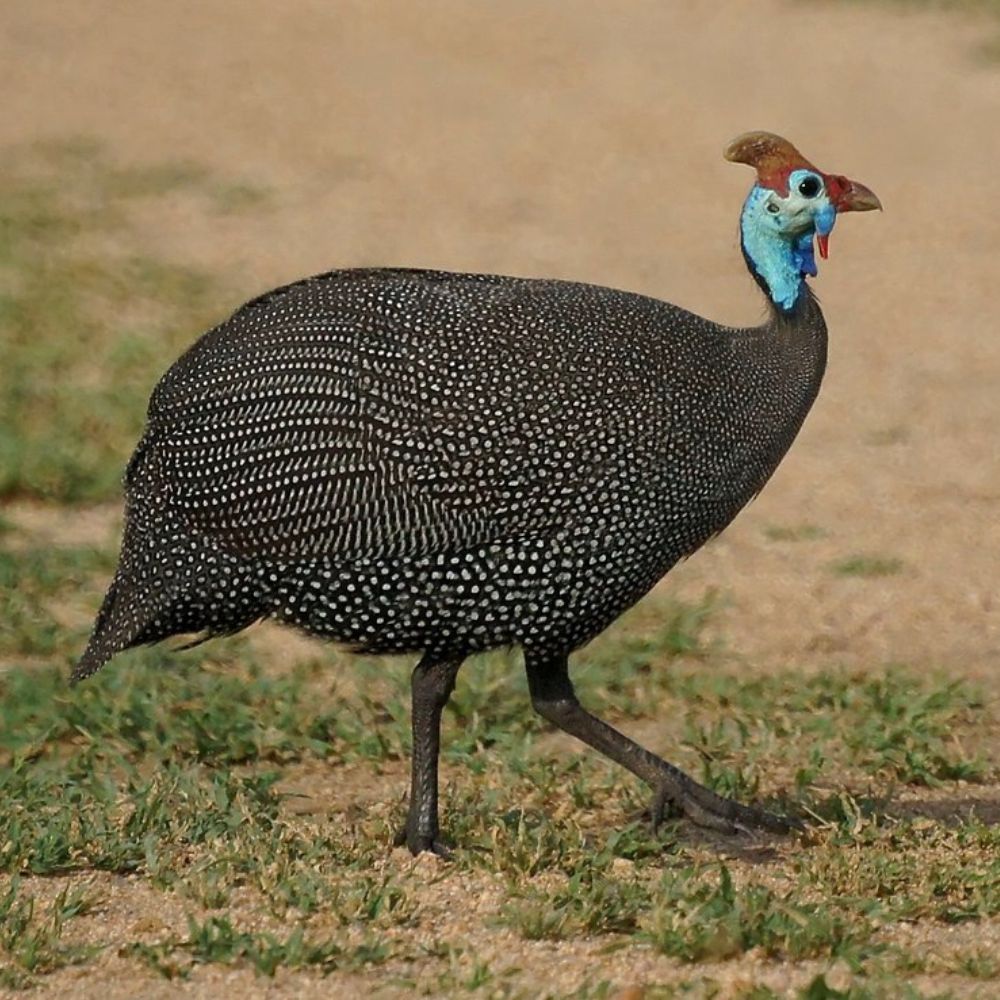
Wikipedia
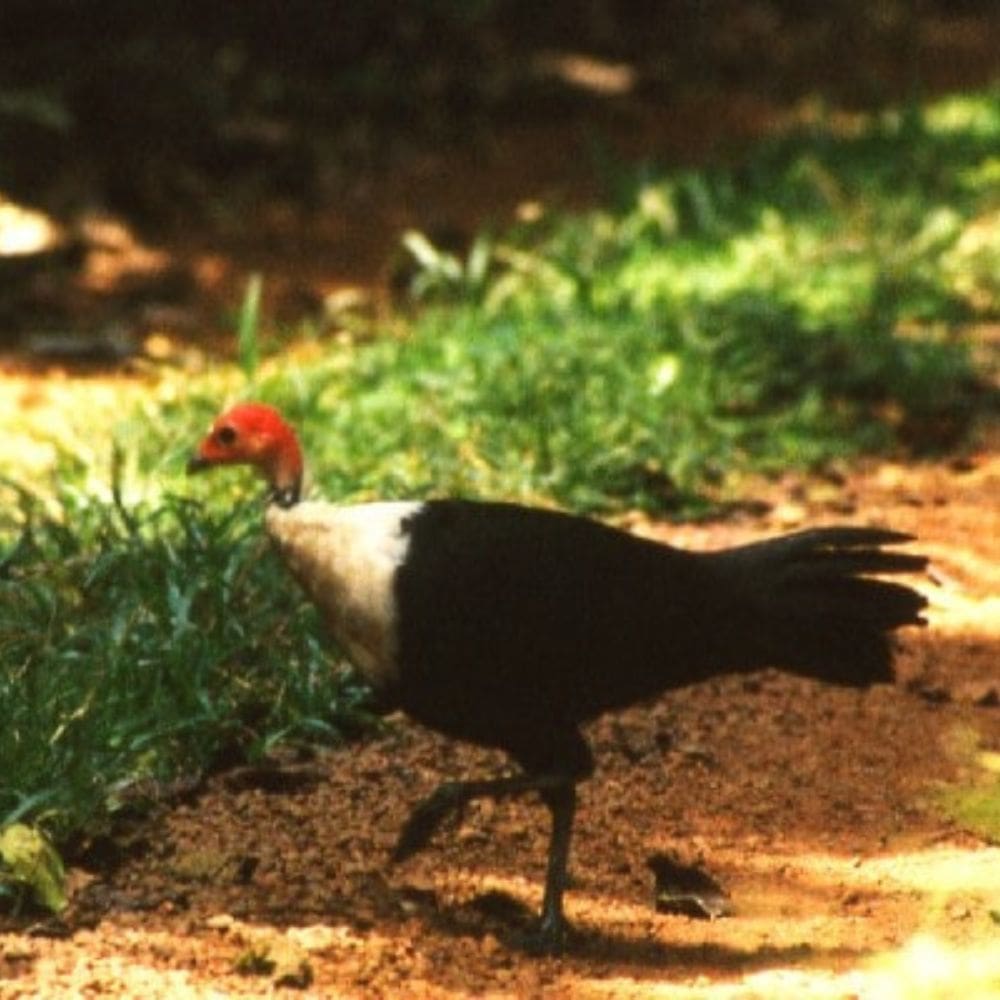
AfricanBirdClub.org
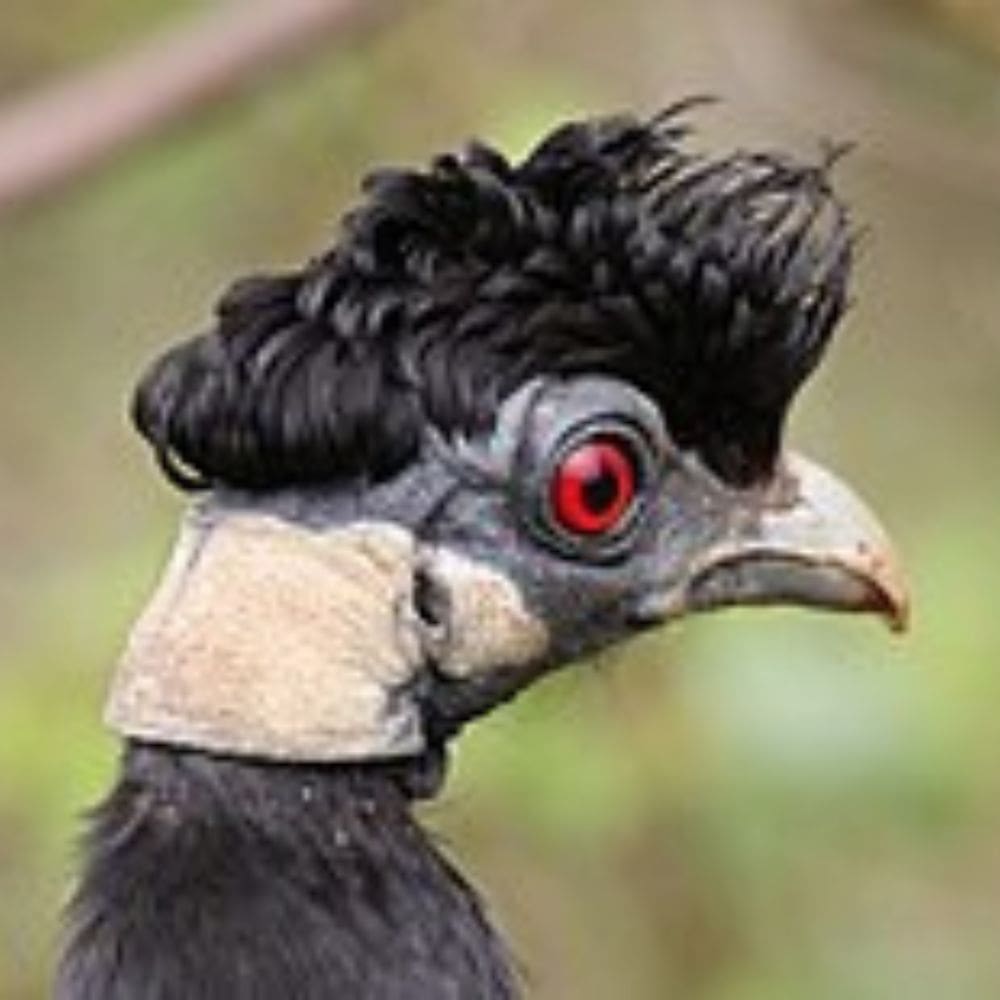
Wikipedia
According to the Poultry Extension Website, there are three main varieties of helmeted guinea fowl raised in the United States: pearl, white, and lavender. The pearl variety is the one most of us recognize as a “Guinea Hen.”
What Are Guineas Good For?
Pest Control
Beauty may be in the eyes of the beholder, but all the benefits of a Guinea hen are just plain facts. Guineas are excellent at pest control; from disease-carrying ticks (like blacklegged ticks and wood ticks) to grasshoppers and flies, to slugs, crickets, caterpillars, and beetles…all the way to rodents like mice and small rats (and even small snakes)!
They will eat bees too, which might present a problem if you are a beekeeper. Keep that in mind.
The list of sneaky little pests they eat goes on and on…but in my opinion, their ability to control the flea and tick population is one of their best attributes (since those nasty little critters carry diseases and are harmful to us and our pets). It’s even reported that Guineas can clean up a garden or crop area without damaging the crops!
Watchdogs
In addition to their amazing ability to eat an unbelievable amount of bothersome insects, they also have an alarm sound they make when danger or something out of the ordinary is around (listen to the sound here). They are a bit like a watchdog so to speak. Some people might find this alarming sound to be…well…alarming! And annoying, but some find it very helpful.
Guineas are also attached to each other within their flock. They run around together in a group, very similar to Runner ducks. If one of them strays off, they will start calling for the little lost sheep…uh hum…bird.
Egg Production
Guineas are capable of laying eggs, although egg-laying is not what they are best known for. They only lay for part of the year and may lay up to 100 eggs. Guinea fowl eggs are a little smaller than chicken eggs.
If you want fertilized eggs you will need about one male to every 5 or 6 females.
Meat
Better than egg laying, is their meat-making ability. Guinea fowl meat has been touted as the poor man’s meat because it’s a less expensive luxury meat than some other luxury fowl (like Pheasants). Their meat is sometimes described as a bit gamey (which you may or may not like) but it is full of essential amino acids.
Guineafowl Personality and Temperament
Are they friendly? Sort of. Many people will tell you they have friendly guineas. But remember, they are more wild than chickens. They tend not to be super-dooper chummy. They are, however, quirky and super fun to watch as they are quite entertaining.
Guineas are incredibly active, easy to alarm, and not the sharpest tools in the shed (except for flying to high tree tops which helps them avoid predators).
They do NOT like to be alone. So like goats, one guinea makes an unhappy guinea AND an unhappy guinea owner.
Guinea Hen Hardiness Scale
On a scale from 1 to 10, I’d say they are a 9 on the hardiness scale. Guineas are from Africa, so naturally, they are hot-weather birds and they have no trouble with the heat.
Even so, they also have no problem with extremely cold climates, although many say they don’t tolerate snow well. I live in an area that gets snow every year (albeit only 3 to 5 snows or sleets per year) and they do fine. They just need a shelter to retreat to when their feet and legs get too cold.
They fly quite well and will fly to the tops of trees if their wings are not clipped. This treetop tendency does help them avoid predators at night if you let them live a free-range life.
What Does a Guinea Hen Need To Be Fed?
According to the Poultry Extension website, their diet is different than chickens – especially the keets (chicks). Their protein requirements are more in line with game birds. If they don’t get enough protein, they won’t be healthy and also won’t lay eggs nearly as often (or at all).
If for any reason guinea fowl are not allowed to forage, they can be fed a commercial poultry diet. It is important to use an unmedicated feed. Guineas need a higher protein feed than chickens but do quite well on regular poultry diets. Keets need a 24% to 26% protein ration as the starter feed. The protein level should be reduced to 18% to 20% for the fifth to eighth weeks. After eight weeks, the keets can be fed a 16% layer mash. If your feed mill does not sell feeds in the proper protein levels, you can mix a higher protein feed with a laying-hen mash to get the proper protein level. Guineas should be fed mash or crumbles. Pelleted feed is not recommended for guineas.
Poutry Extension Website
They will eat treats, and this helps them to warm up to the hands that feed them. 😊👐 Try my favorite, nutritious treats by clicking here.
Can Guineas Live With Chickens?
Yes, they can. However, they still have some “wild bird” in their genes and are not as easy to tame. That doesn’t keep them from doing their excellent foraging and guard bird duties though!
Also, it’s not a great idea to keep a male guinea cooped up with your flock if you have a rooster. Guinea males will tend to run the roosters off and keep them from food and water. If you are free-ranging your guineas, then it’s not as big of a deal. You should do more research based on your particular situation and setup.
Interesting Facts About Guineafowl
- Some people call them Guineafowl and some people call them Guinea Fowl
- Guineas are considered poultry
- Guineafowl are regarded as low maintenance
- Guinea meat flavor is often compared to pheasant meat
- They are related to turkeys and gamefowl (as you can tell by looking at them)
- Guinea eggs are smaller than chicken eggs and have a very hard shell
- A baby Guinea is not called a chick, but rather a Guinea keets
- When they decide to make a nest, good luck finding it (they are very good at hiding them)
- Guineafowl came to North America with early settlers
Summary
Guineafowls are strange birds indeed. There are many people who adore guineas and could make a list a mile long about why you should own some; such as you can find on the Guinea Fowl Enthusiasts Facebook Group Page.
If you need insects to be drastically reduced and like their quirky appearance…and don’t mind their built-in danger alarms — then Guineas might just be up your alley.
I have two friends that have both had guineas that went rogue. They let them free range and each day they would travel further and further until they didn’t come home. Both friends also loathed how noisy they were. These are anecdotal situations, but they should be food for thought.
Whatever you do — do your research and make sure they are the right fit for you. This is not a bird you want to order on a whim because you want to get an A+ in your chicken math class!😉
Want to compare guineas to other fowl, check out these posts about chickens and ducks!

A happy wife, mother, teacher, writer, hobby farmer, lover of chickens, and contributor to Pampered Chicken Mama!

